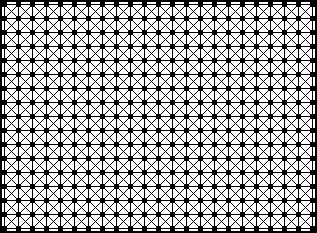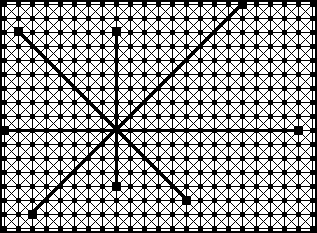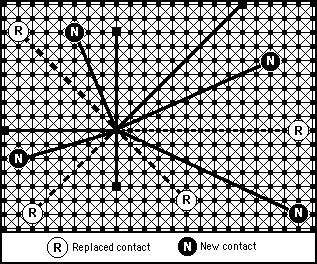
Chapter 6
Exploring the weird
An individual within an information space
In chapter two, we saw how the metamorphose of an individual into a super individual is brought about by an individual building up an appropriate group of close contacts and establishing links into various communities – becoming the centre of a network of on-demand information sources.
This can be viewed as an individual being a node in a vast system of information transference – a point in an information space. This is illustrated in figure 6.1 (Note: this is identical to figure 4.2, but, we are looking at it with an emphasis on the characteristics of the space rather than the individuals).

Figure 6. 1
Individuals in an information space, where information flows around the space through individual nodes communicating with surrounding contact nodes
In the book, "The Ultimate Game of Strategy", it was explained how individuals could enhance the efficiency by which they could acquire information by using the Internet to reach out across the information space to acquire information that was not available from their immediate physical surroundings. This is illustrated in figure 6.2.

Figure 6.2
An individual can greatly enhance their knowledge by using the Internet to reach across the information space to gather information from anywhere on the planet
This second book in the trilogy, also described how the ease and speed of communicating with many contacts in so many different areas can easily lead to an information overload. It described how it would be essential to be able to limit the quantity and control the quality of the available information.
To maximise the efficiency of obtaining information over a wide area, it was proposed that relationships with contacts should be set up so that information is exchanged only on a "need to know" basis and that contacts should be carefully chosen and selected for their appropriateness to current situations in hand.
It was proposed that the most effective way of doing this would be to limit the number of contacts, and arrange that these contacts are changed at frequent intervals according to how useful they are in current situations. This would see the diagram illustrated in figure 6.2 as a snap shot at a particular moment in time of an individual's contacts in information space – when the contacts shown would be appropriate to a given situation at that particular moment in time.
As soon as this particular individual's situation changed, it would be strategically more efficient for the individual to form different links with other contacts in different parts of information space. Seen in this way, information space would be seen as a constantly changing dynamic environment where the communication links between individuals are constantly changing as they each respond to the current demands of their local situations. Figure 6.3 illustrates the way in which some contacts might be replaced by others in the information space as a project or situation goes into a different stage.

Figure 6.3
As a project or situation changes direction, some contacts are dropped to be replaced by others in the information space
Such changes in contacts would be a necessary continuous activity for all individuals in the Internet information space, as everyone pursues different goals in the face of changing technology and fast reacting competition. In the far slower and more predictable world of bricks and mortar, the changing and casting off of contacts would be seen as neither practical nor ethical, but, in the mass connectivity of the world of e-business, establishing, dropping and reestablishing contact with people is so obviously sensible that it is regarded as normal behaviour.